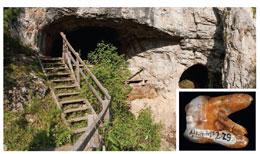Who were the Denisovans? That is the focus of a fascinating Science Magazine feature and the buzz among molecular geneticists.
The Denisova hominin represents an archaic human species living in the Altai Mountains of southern Siberia at least 41,000 years ago. This was an ice-age population.
The results of the complete genome sequence recovered from a finger bone of a female in southern Siberia have been released here.
The growth plates were not fused, indicating that this was a young child. She lived between 30,000 and 80,000 years ago. A comparative analysis of the genome with those of modern humans indicates that this lineage survives in the genes of some inhabitants of Papua New Guinea and islands northeast of Australia. These small populations share one-twentieth of their DNA with the Denisovan population.
The Denisova mtDNA studied indicates a common female ancestor for Neanderthal humans and modern humans.
Biological anthropologist Maria Mednikova of the Russian Academy of Science has said, “It remains unknown what the Denisovan looked like or how he behaved.”
A finger bone of a young girl (found 2008) and a tooth (2000) were discovered in the Denisova Cave in Siberia.
However, the new discovery of a Denisovan toe bone suggests that African, Asian and European populations were interbreeding. This is likely the genetic seedbed of the later Afro-Asiatics.
The molar tooth and the finger bone mtDNA sequences were very similar, indicating that both individuals belonged to the same population.
The precise age of the Denisovan material remains uncertain but corresponds to early migrations out of Africa.
The DNA analysis further indicates that the Denisovan population was the result of an early migration out of Africa. The ancestors of some Papuans and the Denisovans migrated, probably from the Nile region, between 100,000 and 70,000 years ago.
Related reading: Complete Denisovan genome offers glimpse of ancient variation; Fossil genome reveals ancestral link; Genome of Mysterious Extinct Human



.jpg)









3 comments:
The Denisova cave is above the Anui River. This links, via the Amur River, to the ancient Yana River camp (28,000 years old), and the Ainu. The map has many rivers named -dan/-an-/Yen...
http://www.flickr.com/photos/johnhawks/5970257619/
http://en.wikipedia.org/wiki/Yana_River
Yes, and I suspect that one of the populations there was Annu. I'm on the trail, Dude! See this:
http://jandyongenesis.blogspot.com/2012/02/migrations-out-of-africa.html
Derenko et al. (2001) reported
the presence of haplogroup X in Altaian populations of southern Siberia.
Post a Comment